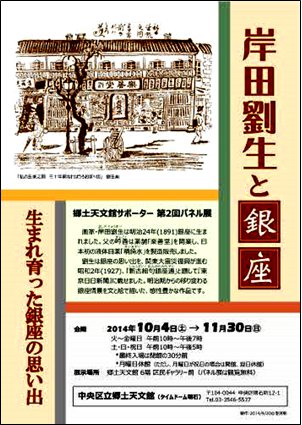At the Chuo Ward Folk Tenmonkan (Time Dome Akashi), the second panel exhibition "Ryusei Kishida and Ginza-Memories of Ginza born and raised-" planned and produced by the supporters of the museum began on October 4. This panel introduces Ginza's memories from the Meiji era serialized by painter Ryusei Kishida in the "Tokyo Nichi-Nichi Shimbun", along with self-painting and reference photographs. The exhibition period is closed on Monday until November 30, free of charge. Specifically, "news center of ward" (2014/10/1) HP Click here>>
 Ryusei Kishida was born in Ginza in 1891 in 1891, and his father Ginka Kishida (1833-1905) served as a journalist and chief writer of the Tokyo Nichi-Nichi Shimbun. In 1875, he opened the pharmaceutical shop "Rakuzendo" in Ginza 2-chome, and manufactured and sold Japan's first liquid eye drop "Seikisui".
Ryusei Kishida was born in Ginza in 1891 in 1891, and his father Ginka Kishida (1833-1905) served as a journalist and chief writer of the Tokyo Nichi-Nichi Shimbun. In 1875, he opened the pharmaceutical shop "Rakuzendo" in Ginza 2-chome, and manufactured and sold Japan's first liquid eye drop "Seikisui".
Liu students pursued original painting expressions, such as creating a "Reiko statue" modeled on his beloved daughter as a painter.
Standing up from the devastating of the Great Kanto Earthquake (September 1923) and aiming for the reconstruction of the Imperial City, the serialization of the "Tokyo Nisshin Shimbun" (evening edition) began in March 1927 (1927). "Has begun.
In this series, Liu wrote a brush in May of the same year, entitled "Shinkozaiku Ginza-dori". This exhibition introduces the first exhibition on the panel. Liu, born and raised in Ginza, depicts the nostalgic Ginza scene before the earthquake with sharp sensitivity of text and illustrations.
In the exhibition, the Ginza-dori house map of 1902 (1902) is posted, so you can see it in comparison with the panel text, and it is interesting to know the transition of Ginza and today's cityscape about 110 years ago.
Two years after this writing, Liu died in 1929 (1929) at the age of 38. @ Akira Makibuchi

